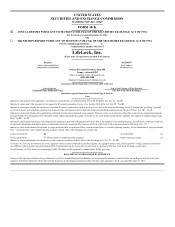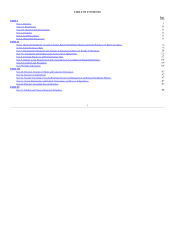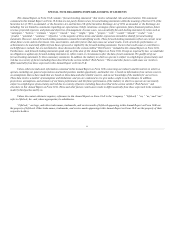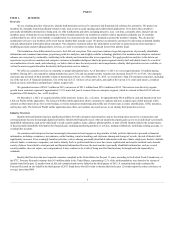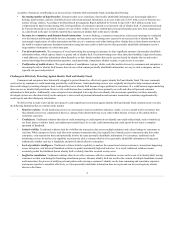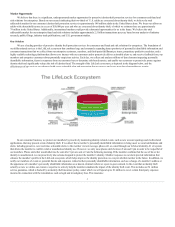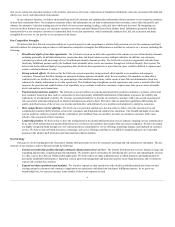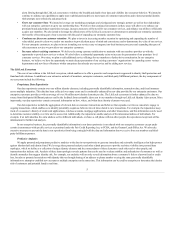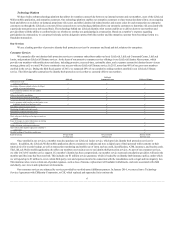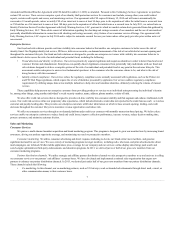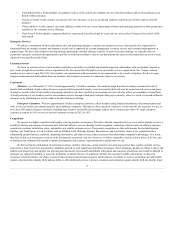LifeLock 2013 Annual Report Download - page 4
Download and view the complete annual report
Please find page 4 of the 2013 LifeLock annual report below. You can navigate through the pages in the report by either clicking on the pages listed below, or by using the keyword search tool below to find specific information within the annual report.
We are a leading provider of proactive identity theft protection services for consumers and fraud and risk solutions for enterprises. We protect our
members by constantly monitoring identity-related events, such as new account openings and credit-related applications. If we detect that a member’s
personally identifiable information is being used, we offer notifications and alerts, including proactive, near real-time, actionable alerts, that provide our
members peace of mind that we are monitoring use of their identity and allow our members to confirm valid or unauthorized identity use. If a member
confirms that the use of his or her identity is unauthorized, we can proactively take actions designed to protect the member’s identity. We also provide
remediation services to our members in the event that an identity theft actually occurs. We protect our enterprise customers by delivering on-demand identity
risk and authentication information about consumers. Our enterprise customers utilize this information in real time to make decisions about opening or
modifying accounts and providing products, services, or credit to consumers to reduce financial losses from identity fraud.
The foundation of our differentiated services is the LifeLock ecosystem. This ecosystem combines large data repositories of personally identifiable
information and consumer transactions, proprietary predictive analytics, and a highly scalable technology platform. Our members and enterprise customers
enhance our ecosystem by continually contributing to the identity and transaction data in our repositories. We apply predictive analytics to the data in our
repositories to provide our members and enterprise customers actionable intelligence that helps protect against identity theft and identity fraud. As a result of
our combination of scale, reach, and technology, we believe that we have the most proactive and comprehensive identity theft protection services available, as
well as the most recognized brand in the identity theft protection services industry.
We offer our consumer services on a monthly or annual subscription basis. As of December 31, 2013, we served approximately 3.0 million paying
members. During 2013, our cumulative ending member base grew 21% and our annual member retention rate increased from 87.1% to 87.8%. Our enterprise
customers pay us based on their monthly volume of transactions with us. As of December 31, 2013, we served mor e than 250 enterprise customers, including
six of the top ten U.S. financial institutions, five of the top six U.S. wireless service providers, and eight of the top ten U.S. credit card issuers, as ranked
based on assets, subscribers, and purchase volume, respectively.
We generated revenue of $369.7 million in 2013, an increase of $93.3 million from $276.4 million in 2012. The increase was driven by organic
growth in our consumer segment of approximately 33.5% and a full year of revenue from our enterprise segment, which we entered in March 2012 with our
acquisition of ID Analytics, Inc., or ID Analytics.
On December 11, 2013, we acquired mobile wallet innovator Lemon, Inc., or Lemon, for approximately $42.4 million in cash and launched our new
LifeLock Wallet mobile application. The LifeLock Wallet mobile application allows consumers to replicate and store a digital copy of their personal wallet
contents on their smart device for records backup, as well as transaction monitoring and mobile use of items such as credit, identification, ATM, insurance,
and loyalty cards. The LifeLock Wallet mobile application also offers our members one-touch access to our identity theft protection services.
Identity theft and identity fraud are significant problems for both consumers and enterprises and are becoming more pervasive as transactions and
communications become increasingly digital and mobile. Identity theft typically occurs when an unauthorized party gains access to an individual’s personally
identifiable information, such as the individual’s social security number, name, address, phone number, or date of birth. Identity fraud is the actual misuse
of the personally identifiable information for financial gain, including purchasing products or services, making withdrawals, modifying existing accounts, or
creating false accounts.
As consumers and enterprises become increasingly interconnected and engage in a large number of daily activities that involve personal or financial
information, including e-commerce, m-commerce, online banking, social networking, and electronic sharing and storage of records, the risk of identity theft
significantly increases. Even seemingly harmless activities, such as sharing personally identifiable information with mer chants, employers, doctors, dentists,
schools, banks, or insurance companies, can lead to identity theft, as professional thieves now have more sophisticated and creative methods and a broader
variety of places from which to steal personal and financial information. Because the most sensitive personally identifiable information, such as a social
security number, does not expire, once compromised, it may continue to be at risk of being used for fraud and may be bought and sold repeatedly by
criminals.
Identity theft has been the most reported consumer complaint in the United States for the past 13 years, according to the Federal Trade Commission, or
the FTC. Forrester Research estimates that 14.9 million adults in the United States, representing 6.2 % of the adult population, were found to be victims of
identity fraud in the past 12 months from a LifeLock-commissioned survey fielded in the third quarter of 2013. A commissioned study conducted by
Forrester Research on our behalf in the third quarter of 2013 found those who fell victim to identity theft in the past 12 months report the crime cost them, on
average, more than $800.
1

